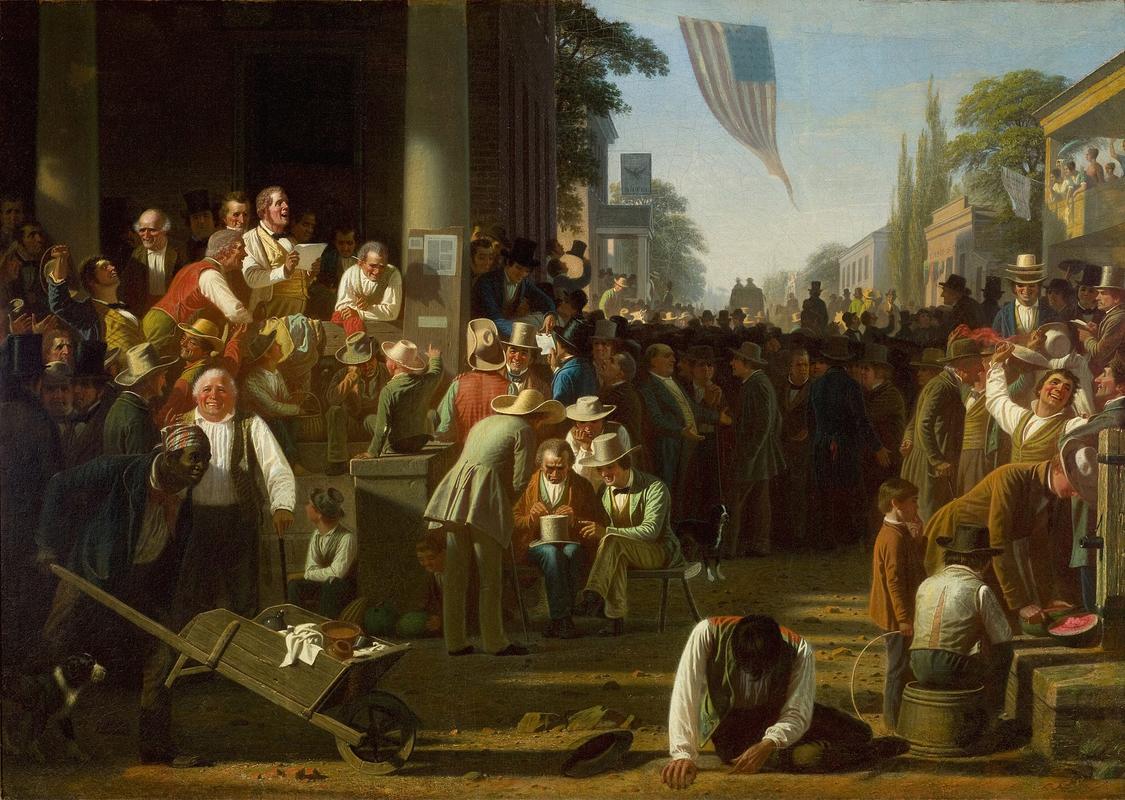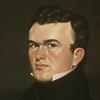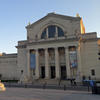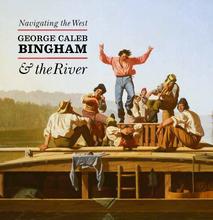More about The Verdict of the People
- All
- Info
- Shop

Sr. Contributor
A George Caleb Bingham painting made headlines after the 2016 presidential election; unfortunately, it was for all the wrong reasons.
As is tradition, an American painting serves as the backdrop for each president’s inaugural luncheon. Apparently, Senator Roy Blunt, a Republican from Missouri, initiated the loan of George Caleb Bingham’s The Verdict of the People in July 2016, four months before anyone knew what we were in for. Based on the next four years, perhaps a more fitting painting would have been Francisco Goya's Saturn Devouring His Son.
Now, it’s not that Bingham’s painting itself is bad, but it is steeped in a complicated and problematic history. The painting essentially represents the stilted and imperfect version of democracy that reigned in the antebellum South, where those in power infused their politics with racism and promoted the subjugation of enslaved Black people that made their plantations possible (and very lucrative) for their white owners. Part of a three-part series depicting the American electoral process, this scene shows the announcement of election results and the myriad reactions that inevitably follow. Although Bingham sought to portray a diverse voting population, they all look like white men to me. He goes so far as to try to include some of those who were barred from the voting process – Black people and white women – but they are relegated to the shadows and background, respectively.
The moral question of slavery embroiled the citizens of 1855 Missouri, setting the scene for why this painting stokes so much opposition. Bingham was an anti-slavery Whig who fought against the expansion of slavery into the territories. Members of the Democratic party, on the other hand, either supported slavery or remained complicit in their silence. To settle the score, Congress passed the Kansas-Nebraska Act of 1854, just one year before Bingham created this painting. This act allowed the issue of slavery to be chosen by a popular vote – the very kind of vote to which Verdict of the People alludes. As it happened, pro-slavery Missourians, determined to allow Kansas to become a slave state, crossed the border to attack abolitionist settlers and sway the vote. Would the democratic process of the time be fair and allow for the right decision to be made? According to this work, Bingham didn’t seem to think so.
The validity of the popular vote remains a contemporary issue. When Donald Trump’s campaign and ultimate election brought so much strife to the nation, many couldn’t believe that his rise to office was truly a verdict of the people. Citing that Trump lost the popular vote by three million votes, an artist and art historian teamed up to defend that his election was not backed by the people of the United States. They also claimed that the loan by the Saint Louis Art Museum constituted an endorsement of the new president. Claiming to remain non-partisan, the museum did not balk.
Unsurprisingly, Trump broke from the tradition of displaying an artwork of either a previous president or an American landscape at his luncheon. Rembrandt Peale’s portrait of George Washington hung at George H.W. Bush’s 1989 luncheon. Thomas Sully’s portrait of Thomas Jefferson was displayed at both of Bill Clinton’s inaugural luncheons in 1993 and 1997. Keeping with the landscape tradition, George W. Bush’s 2005 luncheon featured Wind River, Wyoming by Albert Bierstadt.
Sources
- Barone, Joshua. “St. Louis Art Museum Faces Backlash Over Artwork’s Role in Trump Inauguration.” Art & Design. The New York Times. 5 January 2017. https://www.nytimes.com/2017/01/05/arts/design/st-louis-art-museum-back…
- Kennicott, Philip. “The controversy behind the painting that will hang at Trump’s inaugural luncheon.” Museums. The Washington Post. 13 January 2017. https://www.washingtonpost.com/entertainment/museums/donald-trump-will-…
- Saint Louis Art Museum. “The Verdict of the People.” Collection. https://www.slam.org/collection/objects/29776/. Accessed 7 July 2020.
- Smithsonian Institution. “George Caleb Bingham.” Art + Artists. Smithsonian American Art Museum. https://americanart.si.edu/artist/george-caleb-bingham-6356. Accessed 7 July 2020.
- The Joint Congressional Committee on Inaugural Ceremonies. “Inaugural Luncheon.” https://www.inaugural.senate.gov/about/luncheon/index.html. Accessed 7 July 2020.
- Viveros-Faune, Christian. “A Closer Look at Donald Trump’s Chosen Painting, The Verdict of the People.” Opinion. Artnet. 18 January 2017. https://news.artnet.com/opinion/donald-trump-verdict-of-the-people-8211…. Accessed 7 July 2020.
Featured Content
Here is what Wikipedia says about The Verdict of the People
The Verdict of the People is an 1854 painting by George Caleb Bingham, currently owned by the Saint Louis Art Museum.
The last painting of Bingham's Election Series, The Verdict of the People tells the end of the story represented in the series. Within this painting, Bingham hid several political motives and ideas similar to the rest of the Election Series. Historians say the painting depicts public reaction to a likely proslavery candidate's election victory.
Completed in 1854, the work covered issues of slavery, temperance, and a representative government, subjects that had gone from a local to a national level. During the early 1850s, the temperance movement grew and more states were abolishing alcohol. A book by Herman Humphrey, titled Parallel between Intemperance and Slavery, associated the cause of anti-slavery to that of temperance. Bingham showed his view on intemperance and slavery by painting a banner that said, "Freedom for Virtue[,] Restriction for Vice." The banner referred to temperance by saying that the vice and alcohol would need to be restricted for the people to be free. The banner then references Bingham's ideas of slavery by using the connection of the temperance movement and the anti-slavery movement to show that Bingham thought negatively about slavery and shared that view with intemperance.
When Donald Trump was inaugurated as the 45th president of the United States on Jan. 20, 2017, The Verdict of the People was the chosen painting, hanging on a partition wall behind the ceremonial head table in the Capitol's Statuary Hall.
Check out the full Wikipedia article about The Verdict of the People













